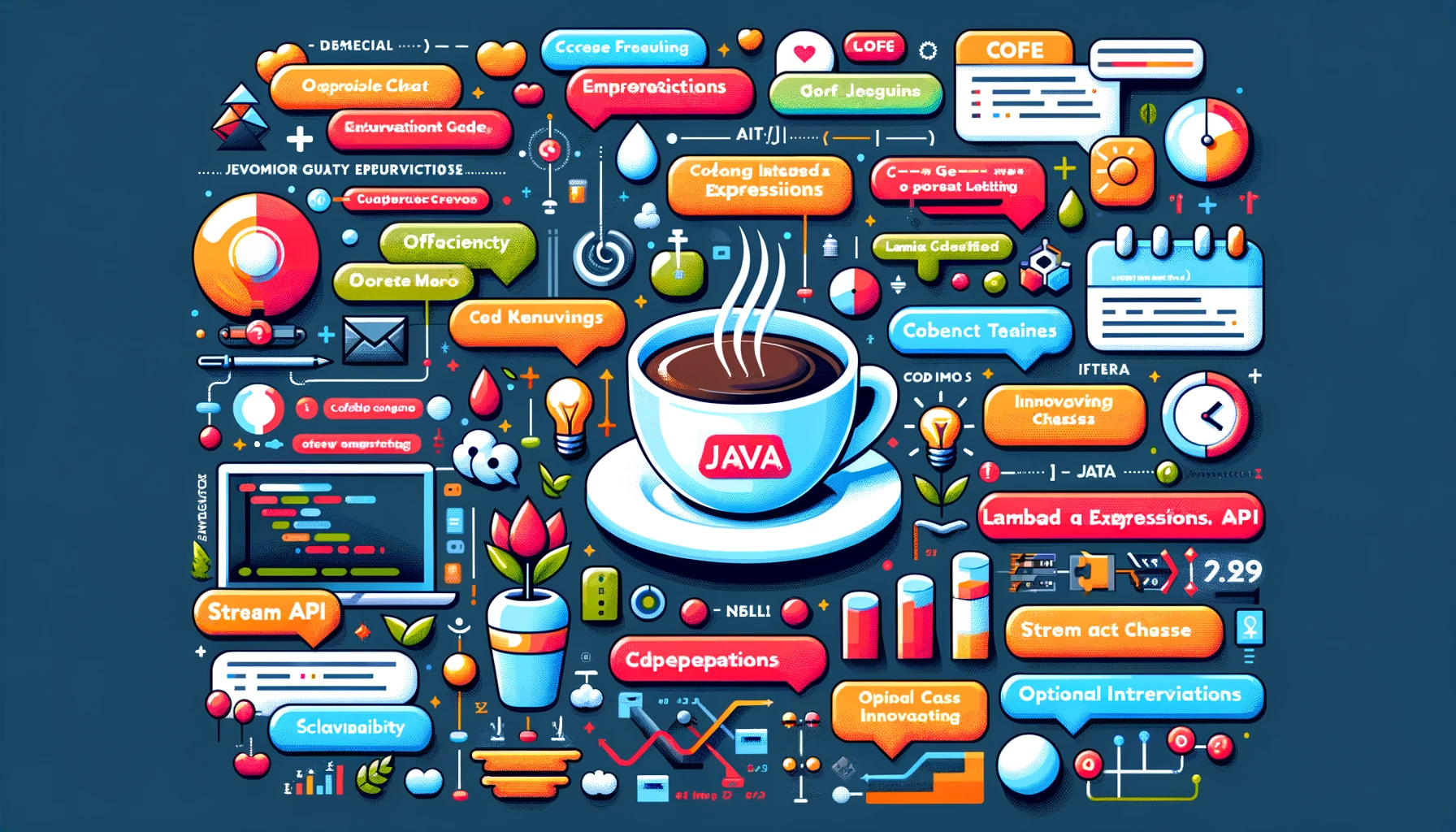Java 8 has been a game-changer in Java programming, introducing powerful features that have become focal points in coding interviews. In this comprehensive guide, we explore key topics related to Java 8 coding interview questions, providing insights, examples, and strategies to help you navigate and excel in technical assessments.
Understanding Java 8 Stream API in Depth
Understanding Java 8 Stream API in depth provides developers with a powerful tool for processing collections concisely and functionally. The Stream API introduces a functional programming paradigm to Java, allowing developers to perform complex operations on data with a more declarative and expressive syntax. Streams enable developers to write more readable and maintainable code using map, filter, and reduce.
A list of integers is squared, then filtered to include only even numbers, and finally, the sum of these squared even numbers is calculated using the reduce operation.
Tips for Efficient Use of Java 8 Streams
- Lazy Evaluation:
Streams use lazy evaluation; operations are deferred until necessary. Chain operations without immediate collection for optimal performance.
- Avoid Stateful Operations:
Minimize stateful operations like distinct or sorted to prevent unnecessary buffering or sorting overhead.
- Choose Appropriate Data Structure:
Select the right data structure (List, Set, Map) based on your needs to impact stream performance positively.
- Parallelize Carefully:
Use parallelStream() for parallel processing with large datasets, but be cautious as it may introduce overhead for smaller ones.
- Use findFirst() for Order:
If order matters, use findFirst() instead of findAny() to ensure predictable results.
Lambda Expressions: Core Concepts and Usage
Lambda expressions in Java provide an expressive way to encapsulate functionality, particularly within the context of functional interfaces. With a concise syntax, such as (parameters) -> expression, lambdas allow the definition of anonymous functions without the need for a formal method declaration. These expressions are commonly employed with functional interfaces. Additionally, lambda expressions support parameter type inference, making code more flexible and concise. They excel in scenarios involving the Streams and Collections API.
The lambda expression takes a String parameter s and prints a message. The lambda.myMethod(“World”) line then invokes this method with the argument “World”.
Java 8 Functional Interfaces and Their Applications
Java 8 introduced functional interfaces as a key feature to support the adoption of functional programming paradigms. Functional interfaces are interfaces with exactly one abstract method, making them compatible with lambda expressions. Here are some commonly used functional interfaces in Java 8 and their applications:
- Runnable
Executing code in a separate thread.
- Callable:
Executing code asynchronously and retrieving a result.
- Comparator:
Defining custom sorting orders for objects.
- Predicate:
Filtering elements based on a condition.
- Function:
Transforming or mapping elements.
- Consumer:
Performing operations on elements without returning a result.
- Supplier:
Providing a source of data or generating values.
These functional interfaces, along with lambda expressions, greatly enhance the expressive power of Java, enabling more concise and readable code in various scenarios. They find extensive use in the Streams API, parallel programming, and functional-style programming constructs.
Advanced Java 8 Features and Their Implementation
Java 8 introduced several advanced features that go beyond the basics of lambda expressions, functional interfaces, and Streams API. Here are some key features and how they can be implemented:
- Optional Class:
Implementation: The Optional class is designed to handle potentially null values without causing NullPointerException. It encourages explicit handling of the presence or absence of a value.
- CompletableFuture:
Implementation: CompletableFuture is used for asynchronous programming. It allows composing asynchronous operations and handling their results.
In interviews, candidates are often asked to demonstrate proficiency in advanced Java 8 features. Here are some examples that are commonly asked:
- Use Java 8 Streams to find the average length of strings in a list.
- Implement a method to retrieve a user’s address and provide a default address if it’s not available.
- Create a custom functional interface to represent a mathematical operation and use it in a lambda expression to perform addition.
- Implement a method to perform two asynchronous tasks and combine their results.
Best Practices for Java 8 Coding Challenges
When tackling coding challenges or interview questions involving Java 8, consider the following best practices:
- Clarity Over Cleverness:
Practice: Prioritize code clarity and readability over overly clever solutions.
Example: Instead of complex one-liners, prefer well-structured and understandable code.
- Thorough Understanding of Stream API:
Practice: Gain a solid understanding of the Streams API and its various operations.
Example: Solve problems using map, filter, reduce, and other stream operations.
- Effective Use of Optional:
Practice: Master the effective use of Optional to handle potentially absent values.
Example: Safely handle cases where a value may or may not be present.
Common Pitfalls in Java 8 Programming
Despite the benefits of Java 8 features, developers often encounter challenges. Here are some common pitfalls to be aware of:
- Null Handling:
- Pitfall: Improper handling of null values can lead to unexpected NullPointerExceptions.
- Best Practice: Use Optional wisely and handle null cases explicitly.
- Mutable State:
- Pitfall: Modifying mutable states within lambda expressions can lead to unintended consequences.
- Best Practice: Prefer immutability and avoid modifying external state.
- Overusing Parallel Streams:
- Pitfall: Indiscriminate use of parallel streams may not always result in performance improvements and can even lead to bottlenecks.
- Best Practice: Benchmark and analyze before opting for parallel streams.
Real-World Problem Solving with Java 8
We already discussed several new features and capabilities in Java 8 that can be used to solve real-world problems.:
- Lambda expressions
- Streams
- Optionals
These features can be used to solve a wide range of real-world problems, including:
- Data processing: Lambda expressions and streams can be used to process large amounts of data in a more efficient and scalable way.
- Asynchronous programming: Java 8 provides several new features for asynchronous programming, such as lambda expressions and CompletableFuture.
- Functional programming: Java 8 supports functional programming, which can lead to more concise and maintainable code.
Exploring Java 8 Date and Time API
The Java 8 Date and Time API provides a modern and comprehensive API for working with dates and times.The Date and Time API includes several new features, such as:
- Temporal objects: Temporal objects represent a point in time, such as a date, time, or instant. They provide a consistent way to represent and manipulate dates and times.
- ZonedDateTime: ZonedDateTime represents a date and time with a time zone. This is useful for working with dates and times across different time zones.
- Duration and Period: Duration represents a period, such as a day or an hour. Period represents a repeated period of time, such as a week or a month.
The Date and Time API can be used to solve a wide range of real-world problems, such as:
- Date and time validation: provides methods for validating dates and times. This can be used to ensure that dates and times are entered correctly.
- Date and time manipulation: provides several methods for manipulating dates and times. This can be used to convert dates and times between different formats, to calculate the difference between two dates or times, or to generate dates and times based on a given criteria.
- Date and time formatting: provides several formatting options for dates and times. This can be used to display dates and times in a human-readable format.
FAQ:
What are the key features of Java 8’s Stream API, and how are they used in coding interviews?
Key Features of Java 8’s Stream API:
- Stream Creation: Streams can be created from various data sources, such as collections, arrays,..
- Functional Operations: Stream API supports functional-style operations like map, filter, and reduce, allowing expressive data processing.
- Laziness and Short-Circuiting: Streams perform operations only when required, supporting lazy evaluation. Short-circuiting operations, like findFirst or anyMatch, can optimize performance.
Usage in Coding Interviews:
- Data Transformation: map()
- Filtering: filter()
- Aggregation: reduce()
How do lambda expressions work in Java 8, and what are their practical applications?
Lambda Expressions in Java 8:
- Syntax: are anonymous functions with a parameter list, an arrow (->), and a body.
- Functional Interfaces: are used to implement interfaces with a single abstract method.
Practical Applications:
- Stream API: Lambda expressions are integral for concise stream processing
- Event Handling: Simplifies event handling, especially in GUI applications.
- Concurrency: Facilitates writing clean and parallelizable code with functional interfaces.
What are functional interfaces in Java 8, and how are they implemented in real-world scenarios?
Functional Interfaces in Java 8:
- Definition: An interface with a single abstract method is termed a functional interface.
- @FunctionalInterface: Annotation indicating the intent for the interface to be functional.
Implementation in Real-World Scenarios:
- Lambda Expressions.
- API Design: Often employed in designing APIs where a single method needs to be implemented by users.
- Event Handling: Used in scenarios where only a single method, like an event handler, needs to be implemented.
.







